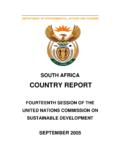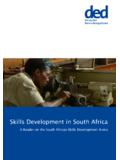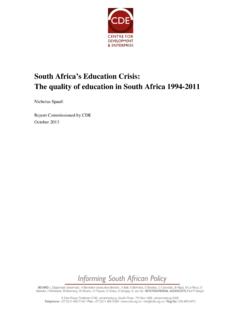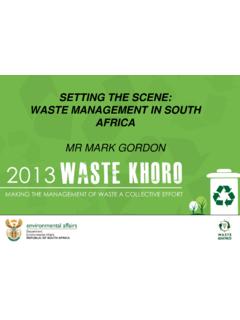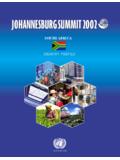Transcription of www.oecd.org/eco/surveys/economic-survey-south- africa
1 OECD economic Surveys south africa July 2017 overview This overview is extracted from the 2017 economic survey of south africa . The survey was discussed at a meeting of the economic and Development Review Committee on 12 June 2017 with participation of representatives of the south African government and representatives of France and Portugal as lead speakers. The survey is published under the responsibility of the Secretary-General of the OECD. This document and any map included herein are without prejudice to the status of or sovereignty over any territory, to the delimitation of international frontiers and boundaries and to the name of any territory, city or area OECD economic Surveys: south africa OECD 2017 You can copy, download or print OECD content for your own use, and you can include excerpts from OECD publications, databases and multimedia products in your own documents, presentations, blogs, websites and teaching materials, provided that suitable acknowledgment of OECD as source and copyright owner is given.
2 All requests for public or commercial use and translation rights should be submitted to Requests for permission to photocopy portions of this material for public or commercial use shall be addressed directly to the Copyright Clearance Center (CCC) at or the Centre fran ais d exploitation du droit de copie (CFC) at OECD economic Surveys: south africa OECD 20179 Executive summary Low growth and high unemployment are weighing on social progress Deepening regional integration of the SADC to boost jobs and growth Boosting entrepreneurship and growing small businesses will contribute to creatingjobsEXECUTIVE SUMMARYOECD economic SURVEYS: south africa OECD 201710 Low growth and high unemployment are weighing on social progressGrowth has disappointed in the last few consumer demand, persistently fallingbusiness investment, policy uncertainty, andthe prolonged drought weighed on power production has improved,important bottlenecks remain in infrastructureand costs of services, which increase the cost ofinputs for firms.
3 The economic slowdown haspushed up the unemployment rate and incomeinequalities remain wide. Reviving economicgrowth is crucial to increase well-being, jobcreation and inclusivity. As there is limitedroom for monetary and fiscal stimulus, boldstructural reforms, supported by social partners,are needed to unlock the economy. Deepening regional integration of the SADC to boost jobs and growthRegional integration offers substantialopportunities for south africa . Despite largegrowth potential, economic integration in thesub-region has not advanced much. Intra-regional trade in the Southern AfricanDevelopment Community (SADC) is only 10% oftotal trade compared to about 25% in the ASEANor 40% in the European Union. Betterimplementation of existing SADC protocols andagreements would advance integration andcreate jobs. Reducing non-tariff barriers byimproving customs procedures and simplifyingrules of origin would reduce trade costs in theregion.
4 Weak infrastructure and institutions andbarriers to competition limit industrialdevelopment. More ambitious and effectiveinfrastructure and investment policies areneeded at the regional entrepreneurship and growing small businesses will contribute to creating jobsBoosting entrepreneurship is crucial to boost jobcreation. Entrepreneurship is low compared toother emerging economies. Slowing growth hascompounded an already difficult environment fornew and small businesses. Steps have been takento ease starting a business, but red tape remains aburden. The quality of the education system andlack of work experience contribute to gaps inentrepreneurial skills. There is scope to broadenthe sources of finance. Government policiesshould provide more financial and non-financialsupport for entrepreneurs and small , a lack of co-ordination and evaluationhampers effective per capita is stagnatingSource:OECD, economic Outlook database; World Bank, World DevelopmentIndicators (database).
5 1 2 rate (LHS)GDP growth (RHS)GDP per Capita (LHS)Share of intra-regional exports% of total exportsSource:IMF, Direction of Trade Statistics; World 2 entrepreneurial activity is low% of working-age population, 2014-16 averageSource:Global Entrepreneurship 2 SUMMARYOECD economic SURVEYS: south africa OECD 201711 MAIN FINDINGSKEY RECOMMENDATIONSM acroeconomic policiesMacroeconomic policies are constrained. Fiscal space islimited and higher interest payments push public debtup. There is scope to increase the effectiveness and mixof government spending. Also, improvements in thegovernance of state-owned enterprises are annual wage increases in the public sector andwhere possible redeploy civil servants to priority the effectiveness of public spending to free upresources for infrastructure and education. Deepen implementation of public procurement reformand enforce sanctions for breaches of the Public FinancialManagement Act.
6 Ensure that state-owned enterprises respect procurementand expenditure rules. Skills shortages and mismatches are key bottlenecks togrowth and inclusiveness. Access to higher educationhas improved but remains up a scheme of universal student loans contingent onfuture incomes, with participation from banks andgovernment minimum wage will reduce inequalities and in-work poverty but adjustment to the higher minimumwage may be complicated by labour market rigiditiesand weak matching of skills. Labour disputes are costlyand reduce flexibility and create a barrier to with the introduction of the national minimumwage and develop apprenticeship and internshipprogrammes to increase youth conciliation and labour arbitration bystrengthening the initial sorting of the number of appeals and time allowed to appeal inlabour regional integration to broaden economic opportunitiesEconomic integration has been slow, reducing growthpotential.
7 Intra-regional trade is low compared to othercommunities. Non-tariff barriers are non-tariffs barriers on intra-regional trade withinSouth African Development Community (SADC).Customs procedures remain costly and rules of origincomplex. Simplify and adopt a single set of rules of origin in theforthcoming tripartite free trade area. Upgrade information technology at custom posts andimprove the interconnectivity of systems within the SouthAfrican Development weak trade and production links in the region reflectlack of proper infrastructure and institutions, skillshortages, regulatory barriers and monopolisticbehaviours that hamper the harmonisation of competition rules among SADC countries and promote competition in infrastructure-related services across special economic zones with better infrastructureand develop their linkages with local a regional fund for infrastructure and increaseprivate sector participation in infrastructure barriers to entrepreneurship and improving the business environmentRed tape and licensing create large burdens forentrepreneurs and small firms.
8 The minimum wagerisks adding to the hiring costs faced by small business. Enact a package of reforms to reduce red tape. Introduce a silence is consent rule for licensing proceduresthat have low associated risks. Systematically review andreduce the stock of red tape and licensing requirements. Regulation of network sectors and services remains highaffecting quality and prices and reducing job up telecommunications, energy, transport andservices sectors to more competition. Attitudes towards entrepreneurship have become morepositive but knowledge and skills gaps second-chance programmes for early entrepreneurial education and work placementsin the post-school education support for new and small businesses couldbe better co-ordinated. Although programmes areregularly audited, the use of impact assessments is notsystematic or and streamline financial and non-financialsupport for start-ups and small businesses.
9 OECD economic Surveys: south africa OECD 201713 Assessment and recommendations Low growth and high unemployment are weighing on social progress and cohesion Low growth is set to continue Macroeconomic policies are constrained Deepening regional integration within the Southern African Development Community Boosting job creation in south africa through more start-ups and SME growth Challenges for green growthASSESSMENT AND RECOMMENDATIONSOECD economic SURVEYS: south africa OECD 201714 Low growth and high unemployment are weighing on social progress and cohesionOver the last two decades, south africa has accomplished enormous social progressby bringing to millions of citizens access to key public services, notably education, health,housing and electricity. Enrolment in primary school is universal for both boys and 90% of households have access to piped water and 84% have access to electricity(Statistics south africa , 2016).
10 An ambitious policy of redistributive grants has also beenput in place, lifting a large share of the population out of poverty. Its legal framework is wellregarded and its judiciary is perceived as independent. The advanced banking system anddeep financial markets have made south africa a regional hub for financial services. Nevertheless, growth has trended down markedly since 2011 due to constraints on thesupply side, in particular electricity shortages and falling commodity prices, and policyuncertainty. Unemployment rose from 25% to 27%. The youth are particularly hard hit bythe economic slowdown, with an unemployment rate of 53% in 2016. Persistent low growthhas led to the stagnation of GDP per capita compared to other fast-growing emergingmarket economies (Figure 1).More recently, in a difficult economic context, several actions, in line with the NationalDevelopment Plan, were taken to restart the economy: To increase confidence in the economy, the government has successfully followed amoderate fiscal consolidation policy that has stabilised the debt level and turned theprimary balance from deficit to 1.










